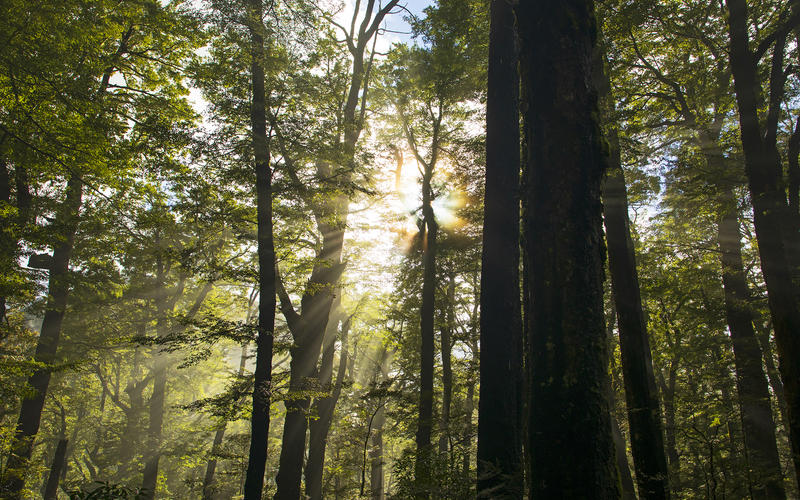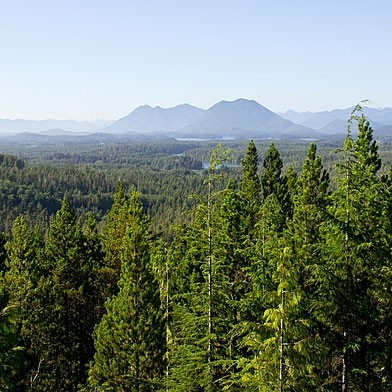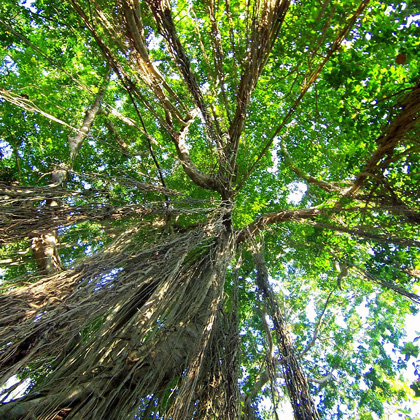Climate change is causing leaves to change color, which may speed up warming

Climate change is causing leaves to change color, which may speed up warming
The way leaves reflect and absorb light can drive the climate of the entire planet. Darker leaves absorb more light, trapping heat and subsequently warming surrounding ecosystems. A recent study shows that climate change may be changing leaf properties, making them darker.
Doughty, Christopher E., Paul Efren Santos-Andrade, Alexander Shenkin, Gregory R. Goldsmith, Lisa P. Bentley, Benjamin Blonder, Sandra Díaz, et al. “Tropical Forest Leaves May Darken in Response to Climate Change.” Nature Ecology & Evolution2, no. 12 (December 1, 2018): 1918–24. https://doi.org/10.1038/s41559-018-0716-y.
The next time you walk through a forest, take a look at the light. The moment you step underneath the trees, the light dims to a dappled green glow. The difference between this lovely lattice and full sunlight comes down to leaves and the way they interact with light.
All the leaves in a forest are doing the same crucial job: they’re soaking up the sun’s light and using it to make sugars that feed the rest of the world. But not all of the sunlight that hits a leaf gets used for sugar-making. Some of the light that isn’t absorbed bounces off the surface of the leaf and is reflected back up at the sky. This reflectance can change the climate of the entire planet.
Darker leaves absorb more light, while lighter-colored leaves reflect more light. Reflectance can influence the climate because light carries heat. When leaves absorb light, they trap that heat. When leaves reflect light, the heat is reflected back at the sky as well. This process controls so much heat that leaf reflectance is a large driving factor in the global climate. For the purposes of cooling our planet, we want leaves that are as light-colored and reflective as possible.
Leaves can change the climate, but can the climate make leaves change in turn? In a recent study, a group of researchers led by Dr. Christopher Doughty wanted to know if climate change could affect the properties of a leaf that control how reflective it is. The team of researchers studied ten different forest sites at increasingly high elevations in the Peruvian Amazon. The elevation gradient spanned 3200 meters, allowing the researchers to demonstrate how leaves may adapt to different temperatures at various elevations.
The reflectivity of leaves is mostly determined by traits like leaf color and leaf mass per area (influenced by factors like leaf thickness and density). At each forest site, the researchers measured these traits, as well as leaf reflectivity. They used a leaf reflectance model to predict how traits and reflectance will change in a two-degrees-warmer world, and used a different climate model to figure out how these altered leaf traits will drive the climate in an atmosphere with increased carbon dioxide.
The leaves in warm, lower elevation sites had lower leaf mass per area and reflected less light in the near infrared spectrum than the leaves at higher elevation sites. Lower reflectance in the near-infrared spectrum means that leaves will get darker and absorb more of the light that hits them. Even within each site, leaf traits skewed based on elevation, showing how readily trees adapt to small variations in temperature.
These startling results illuminate the future of leaves in our changing climate: warmer temperatures may actually make leaves darker in color so that they reflect less light. Leaves are entering into a dangerous feedback cycle, where warm temperatures force plants to build less reflective leaves that then trap heat and warm the world even more. This study focused on tropical forests, but the results likely apply to forests around the world.
So where do we go from here? In our battle against climate change, we need to take a more nuanced view of trees and their effects on the climate. Trees can mitigate climate change, but they can also add to the warming in certain situations, and we can’t always rely on them to save our planet.
Next time you’re in a forest, look at the way that light hits a leaf. There’s more going on than meets the eye.




